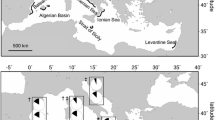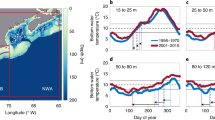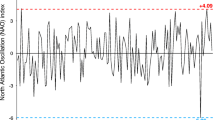Abstract
Whilst a range of animals have been shown to respond behaviourally to components of the Earth’s magnetic field, evidence of the value of this sensory perception for small animals advected by strong flows (wind/ocean currents) is equivocal. We added geomagnetic directional swimming behaviour for North Atlantic loggerhead turtle hatchlings (Caretta caretta) into a high-resolution (1/4°) global general circulation ocean model to simulate 2,925-year-long hatchling trajectories comprising 355,875 locations. A little directional swimming (1–3 h per day) had a major impact on trajectories; simulated hatchlings travelled further south into warmer water. As a result, thermal elevation of hatchling metabolic rates was estimated to be between 63.3 and 114.5% after 220 days. We show that even small animals in strong flows can benefit from geomagnetic orientation and thus the potential implications of directional swimming for other taxa may be broad.



Similar content being viewed by others
References
Blanke B, Speich S, Madec G, Doos K (2001) A global diagnostic of interocean mass transfers. J Phys Oceanogr 31(6):1623–1632
Boles LC, Lohmann KJ (2003) True navigation and magnetic maps in spiny lobsters. Nature 421(6918):60–63
Bonhommeau S, Blanke B, Tréguier A, Grima N, Rivot E, Vermard Y, Greiner E, Le Pape O (2009) How fast can the European eel (Anguilla anguilla) larvae cross the Atlantic ocean? Fish Oceanogr 18(6):371–385
Bonhommeau S, Castonguay M, Rivot E, Sabatié R, Le Pape O (2010) The duration of migration of Atlantic Anguilla larvae. Fish Fish 11(3):289–306
Brattström O, Kjellén N, Alerstam T, Åkesson S (2008) Effects of wind and weather on red admiral, Vanessa atalanta, migration at a coastal site in southern Sweden. Anim Behav 76(2):335–344
Chapman JW, Nesbit RL, Burgin LE, Reynolds DR, Smith AD, Middleton DR, Hill JK (2010) Flight orientation behaviors promote optimal migration trajectories in high-flying insects. Science 327(5966):682–685
Chung FC, Pilcher NJ, Salmon M, Wyneken J (2009) Offshore migratory activity of hawksbill turtle (Eretmochelys imbricata) hatchlings, II. Swimming gaits, swimming speed, and morphological comparisons. Chel Cons Biol 8(1):35–42
Cowen RK, Paris CB, Srinivasan A (2006) Scaling of connectivity in marine populations. Science 311(5760):522–527
Ehrhart LM, Witherington BE (1987) Human and natural causes of marine turtle nest and hatchling mortality and their relationship to hatchling production on an important Florida nesting beach. Florida Game and Fresh Water Fish Commission, Nongame Wildlife Program Tech Rep No 1
Fisher R (2005) Swimming speeds of larval coral reef fishes: impacts on self-recruitment and dispersal. Mar Ecol Prog Ser 285:223–232
Fuxjager MJ, Eastwood BS, Lohmann KJ (2011) Orientation of hatchling loggerhead sea turtles to regional magnetic fields along a transoceanic migratory pathway. J Exp Biol 214:2504–2508
Grist JP, Josey SA, Marsh R, Good S, Coward AC, de Cuevas BA, Alderson SG, New AL, Madec G (2010) The roles of surface heat flux and ocean heat transport during four decades of Atlantic Ocean temperature variability. Ocean Dyn 60(4):771–790
Hays GC, Marsh R (1997) Estimating the age of juvenile loggerhead sea turtles in the north Atlantic. Can J Zool 75(1):40–46
Hochscheid S, Bentivegna F, Speakman JR (2004) Long-term cold acclimation leads to high Q10 effects on oxygen consumption of loggerhead sea turtles Caretta caretta. Physiol Biochem Zool 77(2):209–222
Hughes GR (1974) The sea turltes of south-east Africa II. The biology of the Tongaland loggerhead turtles Caretta caretta L. with comments on the leatherback turtle Dermochelys coriacea and the green turtle Chelonia mydas. L. in the study region. Oceanographic Research Institute Investigational Report, vol 36. Durban, South Africa
Jongejans E, Pedatella NM, Shea K, Skarpaas O, Auhl R (2007) Seed release by invasive thistles: the impact of plant and environmental factors. Proc R Soc London Ser B 274(1624):2457–2464
Kristiansen T, Jorgensen C, Lough R, Vikebo F, Fiksen Ø (2009) Modeling rule-based behavior: habitat selection and the growth-survival trade-off in larval cod. Behav Ecol 20(3):490–500
Large W, Yeager S (2009) The global climatology of an interannually varying air–sea flux data set. Clim Dyn 33(2):341–364
Lohmann K, Cain S, Dodge S, Lohmann C (2001) Regional magnetic fields as navigational markers for sea turtles. Science 294(5541):364–366
Lohmann KJ, Luschi P, Hays GC (2008) Goal navigation and island-finding in sea turtles. J Exp Mar Biol Ecol 356(1–2):83–95
Luschi P, Benhamou S, Girard C, Ciccione S, Roos D, Sudre J, Benvenuti S (2007) Marine turtles use geomagnetic cues during open-sea homing. Curr Biol 17(2):126–133
Marsh R, Desbruyères D, Bamber J, de Cuevas B, Coward A, Aksenov Y (2010) Short-term impacts of enhanced Greenland freshwater fluxes in an eddy-permitting ocean model. Ocean Sci 6(3):749–760
Mencacci R, De Bernardi E, Sale A, Lutjeharms JRE, Luschi P (2010) Influence of oceanic factors on long-distance movements of loggerhead sea turtles displaced in the southwest Indian Ocean. Mar Biol 157:339–349
Merrill MW, Salmon M (2010) Magnetic orientation by hatchling loggerhead sea turtles (Caretta caretta) from the Gulf of Mexico. Mar Biol 158(1):101–112
Metcalfe NB, Taylor AC, Thorpe JE (1995) Metabolic rate, social status and life-history strategies in Atlantic salmon. Anim Behav 49(2):431–436
Milsom WK (1975) Development of buoyancy control in juvenile Atlantic loggerhead turtles, Caretta caretta. Copeia 1975:758–762
Nagelkerken I, Pors LPJJ, Hoetjes P (2003) Swimming behaviour and dispersal patterns of headstarted loggerhead turtles Caretta caretta. Aquat Ecol 37:183–190
Nathan R, Safriel UN, Noy Meir I, Schiller G (1999) Seed release without fire in Pinus halepensis, a Mediterranean serotinous wind dispersed tree. J Ecol 87(4):659–669
Owens DW, Ralph CL (1978) The pineal-paraphyseal complex of sea turtles 1. Light microscopic descriptions. J Morphol 158(2):169–179
Putman NF, Endres CS, Lohmann CMF, Lohmann KJ (2011) Longitude perception and bicoordinate magnetic maps in sea turtles. Curr Biol 21(1):1–4
R Development Core Team (2009) R: a language and environment for statistical computing. R Foundation for Statistical Computing, Vienna, Austria. ISBN 3-900051-07-0, http://www.R-project.org
Salmon M, Wyneken J (1987) Orientation and swimming behavior of hatchling loggerhead turtles Caretta caretta L. during their offshore migration. J Exp Mar Biol Ecol 109(2):137–153
Uppala SM, Kållberg P, Simmons A, Andrae U, Bechtold VDC, Fiorino M, Gibson J, Haseler J, Hernandez A, Kelly G (2005) The ERA-40 re-analysis. Q J R Meteor Soc 131(612):2961–3012
Wiltschko W, Wiltschko R (1996) Magnetic orientation in Birds. J Exp Biol 199:29–38
Wiltschko W, Wiltschko R (2005) Magnetic orientation and magnetoreception in birds and other animals. J Comp Physiol A 191(8):675–693
Witherington BE (1991) Orientation of hatchling loggerhead turtles at sea off artificially lighted and dark beaches. J Exp Mar Biol Ecol 149(1):1–11
Witherington BE (2002) Ecology of neonate loggerhead turtles inhabiting lines of downwelling near a Gulf Stream front. Mar Biol 140:843–853
Wyneken J, Madrak SV, Salmon M, Foote J (2008) Migratory activity by hatchling loggerhead sea turtles (Caretta caretta L.): evidence for divergence between nesting groups. Mar Biol 156(2):171– 178
Acknowledgments
RS was funded through a PhD studentship awarded to GCH from the Natural Environment Research Council. Additional support was provided by the Climate Change Consortium for Wales (C3W). We are grateful to Jeff Blundell for assistance in the local implementation of the ARIANE trajectory software, to Christoph Weidemann for help with R code and to Andrew Coward and Beverly de Cuevas (NOC) for making model output from NEMO freely available. We thank Bruno Blanke and Nicolas Grima for freely providing ARIANE to the oceanographic community. NEMO is a state-of-the-art, portable modelling framework developed by a consortium of European institutions, namely the National Center for Scientific Research (CNRS), Paris, the UK Met Office (UKMO), Mercator-Ocean, and the UK National Environment Research Council (NERC). The latter development is funded under the NERC “Oceans 2025” programme.
Author information
Authors and Affiliations
Corresponding author
Additional information
Communicated by J. D. R. Houghton.
Rights and permissions
About this article
Cite this article
Scott, R., Marsh, R. & Hays, G.C. A little movement orientated to the geomagnetic field makes a big difference in strong flows. Mar Biol 159, 481–488 (2012). https://doi.org/10.1007/s00227-011-1825-1
Received:
Accepted:
Published:
Issue Date:
DOI: https://doi.org/10.1007/s00227-011-1825-1




